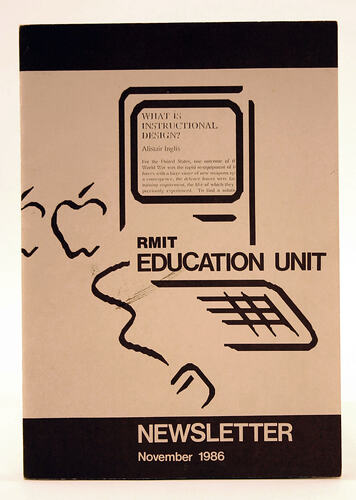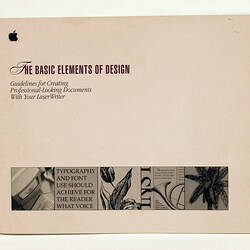Summary
Booklet, called the RMIT Education Unit Newsletter, an early example of desktop publishing. It was published in November 1986. RMIT stands for Royal Melbourne Institute of Technology.
In November 1986, the donor and a colleague produced this newsletter. It is an early example of desktop publishing. They used a Macintosh Plus with an external floppy disk drive and MacPaint, MacWrite and MacDraw software. Aldus PageMaker software was then used to combine the files from the three packages into one file. Aldus PageMaker made it possible for the first time to easily arrange text and graphics in columns.
A Macintosh Plus computer using the Aldus PageMaker software was used to produce the basic page design, incorporating most of the text and graphics. The PageMaker document was printed out using a LaserWriter.
The print-out was then worked on further by a graphic artist, who incorporated photographs and additional art work, that is using non-digital technologies. The master copy on paper was then sent to the printer.
The donor observed that within a very short period of time, preparing documents using desktop publishing software became common place. Those who did it seriously needed to learn much about typography and page design. Many experimented, often badly, with the use of such things as multiple type faces, type sizes, text justification and boxing of text. It was a whole new world that gave the control of what was printed to the person who generated the document at the computer, and removed that control from the printery, the typist or the graphic artist. Documents could be generated or amended much closer to the time of publication.
Part of a representative collection of hardware, software, trade literature and promotional material that documents the history of the Apple company, and its contribution to, and impact on the computer industry and society.
Physical Description
A stapled A4 booklet of 18 paper pages
More Information
-
Collection Names
The Apple Company Collection, Internet Macintosh User Group (iMug) Collection
-
Collecting Areas
-
Acquisition Information
Donation
-
Publisher
RMIT Education Unit, Melbourne, Greater Melbourne, Victoria, Australia, 1986
-
Inscriptions
Included on the cover: "RMIT Education Unit , Newsletter November 1986" What is Instructional Design? Alistair Inglis
-
Brand Names
-
Classification
-
Category
-
Discipline
-
Type of item
-
Overall Dimensions
297 mm (Length), 210 mm (Width), 3 mm (Height)
-
Keywords


